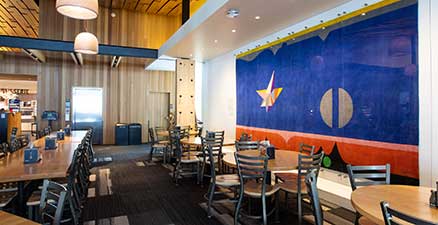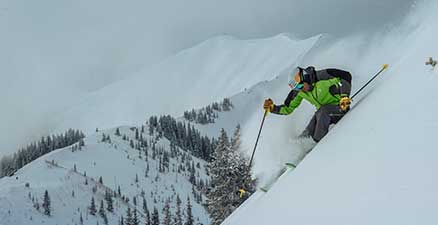Celebrating 100 Years Of Bauhaus In Aspen

The cultural movement that started in Germany 100 years ago as the Bauhaus, a modernist art school, has had a profound influence on this small, but certainly not inconsequential place – Aspen. It flourished here as a Bauhaus epicenter and today its impact often goes unnoticed. Not this year. Enter Bauhaus 100: Aspen, an eight-month celebration that informs and immerses with interactive art classes, lectures, walking tours, exhibits and parties. Aspen’s Bauhaus maven Lissa Ballinger hopes that “visitors and residents alike will understand the unique history of Aspen and how imbedded the arts are in the founding of modern Aspen.”
What Is Bauhaus?
Established in 1919 in Wiemar, Germany the Bauhaus is considered the most influential art and design school in history. The Bauhaus artists created with a philosophy of functional design to enhance the quality of life for all people while striving to create a total work of art. The school was closed by the Nazis but the Bauhaus idea lived on and had a major influence on 20th Century art, architecture and design that often goes unrecognized.
Architectural designs with flat roofs, expanses of glass, and basic geometric shapes have roots in the Bauhaus movement. Sans-serif fonts (typefaces without flourishes) were developed by Bauhaus designers.
Architectural designs with flat roofs, expanses of glass, and basic geometric shapes have roots in the Bauhaus movement. Sans-serif fonts (typefaces without flourishes) were developed by Bauhaus designers.
“I hope that visitors and residents alike will understand the unique history of Aspen and how imbedded the arts are in the founding of modern Aspen.”
–Lissa Ballinger,
Bauhaus 100: Aspen Committee Member
–Lissa Ballinger,
Bauhaus 100: Aspen Committee Member
How Bauhaus Came To Aspen
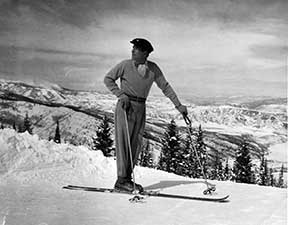
Walter Paepcke, best known for founding the Aspen Institute and the Aspen Skiing Company, brought Herbert Bayer, a Bauhaus-trained designer to Aspen in 1946 to help market and promote Aspen. Bayer was an avid skier who grew up in the Austrian Alps. Bayer’s influence expanded well-beyond Aspen Institute and Aspen Music Festival summer program brochures. Through his posters, advertisements, and other promotional materials, Aspen became known as an exciting ski resort attracting athletes and tourists alike. Bayer became very active in understanding the needs of the community, worked to preserve historic structures and provided guidance for new construction. His most visible influence is the architecture and landscape design of the Aspen Institute Campus.
“Less prominent, but equally important is that Bayer was insistent in protecting the Victorian architecture of Aspen, and making Aspen a town that is open to modern architecture, rather than imitating the past or emulating architecture of Swiss ski villages,” said Ballinger, Aspen Institute curator and Bauhaus 100 committee member. “The Bauhaus philosophies, such as ‘process over product’ and ‘form follows functions’ still resonate with many architects, designers and thinkers in the Valley as well.”
Bayer lived in Aspen for nearly 30 years until he moved to California with his wife in 1975 for health reasons.
Bayer lived in Aspen for nearly 30 years until he moved to California with his wife in 1975 for health reasons.
Getting Your Bauhaus Bearings
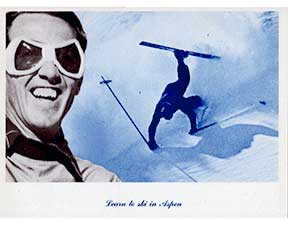
A visit to the Wheeler/Stallard Museum is the perfect jumping off point before moving on to other Bauhaus 100: Aspen events. The Aspen Historical Society’s exhibit: “bayer & bauhaus: how design shaped aspen” lets you explore Bayer’s art and his contributions to Aspen as a cultural and skiing haven. This never-before-exhibited Bayer collection shares a glimpse of Bayer’s lasting impact. Visitors will see preliminary sketch studies and original prints of Aspen ski posters, stationery sketches for the Hotel Jerome, a playful Aspen postcard series, architectural drawings of the original Sundeck restaurant, historical photographs and more.
“Herbert Bayer believed in making life better for everyone – not just the elite, but for the common man,” said Aspen Historical Society Curator, Lisa Hancock. Having grown up in Aspen, Hancock found a new appreciation of the modern aesthetic as she worked on the exhibit. She discovered that some of the aspects of Aspen architecture that she had long admired were Bayer-inspired, such as the Bayer fences distinguished by their crenellated tops and slender pickets. As Hancock states in the exhibit catalogue, the exhibit “will change the way you view Aspen, whether this is your first visit, or have spent a lifetime here.”
The Original Sundeck – Architectural Ingenuity
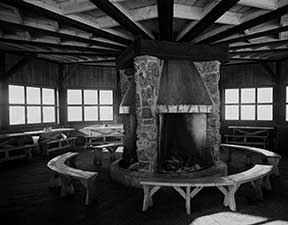
The original Sundeck Restaurant on top of Aspen Mountain is an example of Bayer’s architectural ingenuity. Built in 1946, the Sundeck was designed as an octagonal to optimize 360 degree views. Since there was no water there, the structure featured an inverted roof to capture snow that was melted by the central fireplace. The fireplace in today’s Sundeck building is a replica of the original.
Bauhaus 100: Aspen Celebration Highlights
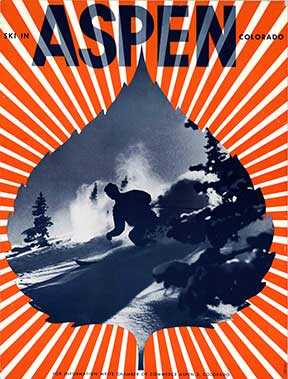
With so many Bauhaus 100: Aspen events and activities throughout the valley, here are a few highlights. For a more complete listing check out the Bauhaus 100: Aspen website.
Start with Bauhaus Evening: Why Bauhaus? Why Aspen? Why 2019? (Wednesday, January 9; 7:30–8:30pm at the Limelight Hotel). Learn about the Bauhaus influence on Aspen through a lively and illuminating panel discussion with Aspen Art Museum co-founder and former assistant to Herbert Bayer Dick Carter, landscape architect Ann Mullins and architect Harry Teague in conversation with moderator Steven Wickes. This event is sponsored by the Aspen Institute.
Visit the Wintersculpt ice carving contest during Aspen’s Winterskol celebration (January 10–13). Watch participants carve an 8' square foot cube of snow in 48 hours on the Aspen pedestrian mall. The theme for Wintersculpt 2019 coincides with this year’s Winterskol slogan “Aspen, Original by Design.” Sculptures will be inspired by Bauhaus design principles. Anderson Ranch Arts Center is the partner for this event.
Start with Bauhaus Evening: Why Bauhaus? Why Aspen? Why 2019? (Wednesday, January 9; 7:30–8:30pm at the Limelight Hotel). Learn about the Bauhaus influence on Aspen through a lively and illuminating panel discussion with Aspen Art Museum co-founder and former assistant to Herbert Bayer Dick Carter, landscape architect Ann Mullins and architect Harry Teague in conversation with moderator Steven Wickes. This event is sponsored by the Aspen Institute.
Visit the Wintersculpt ice carving contest during Aspen’s Winterskol celebration (January 10–13). Watch participants carve an 8' square foot cube of snow in 48 hours on the Aspen pedestrian mall. The theme for Wintersculpt 2019 coincides with this year’s Winterskol slogan “Aspen, Original by Design.” Sculptures will be inspired by Bauhaus design principles. Anderson Ranch Arts Center is the partner for this event.
The Bauhaus Ball on June 6th! A free, community event sponsored by the Wheeler and the City of Aspen. This event will showcase a juried show of artwork that Aspen High School students have created over the year and also have a Bauhaus-inspired costume contest.
Looking back couldn’t be more interesting and fun in 2019!
FOR ASPEN SKI HISTORY BUFFS
Catch old (really old) ski movies from Aspen’s earlier days on second Fridays, January–April at 5:30pm at the Limelight Hotel courtesy of the Aspen Historical Society. January 11: The '40s; February 8: The '50s; March 8: The '60s; April 12: The '70s.Looking back couldn’t be more interesting and fun in 2019!
Photos & Credits:
Top photo – Sundeck in 1950 (top photo): ©Aspen Historical Society, Ringquist Collection
2nd photo down – Herbert Bayer on Aspen Mountain, 1947: ©Aspen Historical Society
3rd photo down – Postcard designed by Herbert Bayer: ©Aspen Historical Society
4th photo down – The interior of the Sundeck restaurant. The central fireplace is surrounded by curved benches. Picnic tables are in front of the exterior walls. 1947: Image by Charles E. Grover (© Aspen Historical Society, Grover Collection)
5th photo down – Bayer's Aspen Skiing Co. promotional poster circa 1950: ©Aspen Historical Society
About The Author

